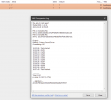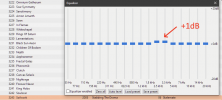- Joined
- Oct 10, 2020
- Messages
- 806
- Likes
- 2,638
I agree.Maybe Erin or Amir should overlay that load dependency plot on the same scale as a typical speaker plot, and it will be easy to see how quickly its lost in the other system variances.
This is how the WiiM Amp frequency response into a dummy "complex load" looks in Erin's review (digitized), note the zoomed-in vertical scale:
This is how the same curve looks if I use the 50dB vertical scale normally used for loudspeaker reviews:
And this is how this curve would affect the anechoic response of a real loudspeaker (e.g. using ASR spinorama of Revel M16):
Note: in reality the response would look a bit different because Revel M16 impedance isn't identical to Erin's complex load - but hopefully this helps to very roughly illustrate the extent of such deviations.




